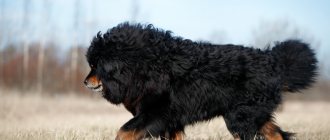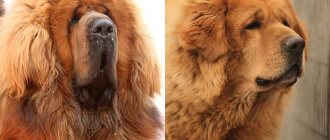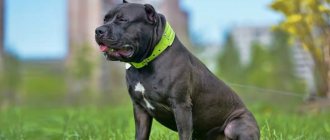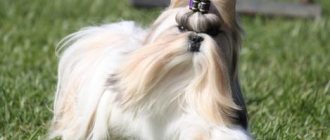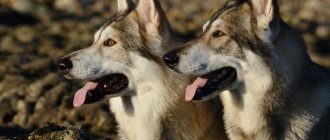- Dogs
The Mastiff is one of the largest dog breeds in the world; it has a voluminous head, well-developed muscles, and great weight. An important problem for this breed is overfeeding of puppies, which has a detrimental effect on their future health. In order to prevent such developments, you should adhere to the basic standards of the breed.
Interesting! The mastiff grows for quite a long time; it gains its final weight by 1.5 years, reaching a weight of 60-75 kg.
Description of the breed
What does a Tibetan Mastiff look like?
Representatives of the breed are significantly larger in size than humans. In the area of the sternum, the fur is thickest, so it looks like a lion's mane. Thanks to this, the dog looks even more voluminous.
In addition to the external component, such wool well protects the animal from bites of wild animals.
Physical characteristics, according to FCI standard:
- The growth of the dog along with the withers affects the body weight. The larger it is, the more unique the individual becomes.
- The head is large in size with a massive and fairly wide skull. The transition from the forehead to the large muzzle is clearly defined. The nose is black, with large, wide-open nostrils.
- Well developed jaw muscles, with a scissor or level bite. The teeth are strong and white.
- The eyes are almond-shaped, the iris has a dark tint.
- The triangular ears are set high on the head and hang down along the muzzle. They are in an elevated state when the dog listens or becomes alert.
- Massive body with a strong skeleton. Deep chest and wide back.
- The medium-length tail widens at the base.
- Strong straight limbs with oval paws.
- The thick and warm fur consists of fine hairs.
Tibetan Mastiff Health
The animal has a good immune system. However, the dog is susceptible to the following ailments:
- disruption of the functioning of intervertebral discs;
- infectious diseases of the ear openings;
- inflammatory damage to tubular bones;
- hereditary damage to the nervous system;
- congenital dislocation of the hip or elbow joints;
- disorders of the thyroid gland.
To prevent the negative consequences of any disease, you need to contact a veterinarian in a timely manner.
One of the most expensive breeds in the world
In 2014, at an exhibition in China, a Tibetan Mastiff puppy was sold for a record sum of 12 million yuan ($1.9 million). Of course, not every dog of this breed costs that much, but this is not an isolated case.
In 2011, a puppy was sold for 10 million yuan ($1.5 million). Is anyone really ready to pay such fabulous sums just to have a cute and beautiful dog?! Not certainly in that way.
These ultra-expensive dogs are considered a symbol of wealth and status among the Chinese elite. Once upon a time, representatives of the breed were used in the countries of Central Asia and Tibet for hunting. There were legends that they had lion's blood flowing in them.
Puppy weight and height by month
A distinctive feature of the characteristics of the Tibetan mastiff is the slow maturation of animals. Ignorance of the dynamics and growth rates of young animals often causes confusion among owners. Therefore, when purchasing a baby, it is better to familiarize yourself with information describing its future development in advance.
Immediately after birth, puppies weigh 400-600 g. The weight of each individual may vary, depending on the total number of babies in the litter. The fewer doggies born, the larger they are at birth. During the first weeks of life, the puppy's body weight increases by 50-150 g per day. The largest individuals can gain 0.5-1.2 kg per week. The growth rate is affected by the number of cubs and the amount of milk from the mother.
Tibetan Mastiff puppy weight table by month
| Age (month) | Weight, kg) |
| Newborn | 0, 4- 0,6 |
| 1 | 5 |
| 2 | 11 |
| 3 | 15 |
| 4 | 17 |
| 5 | 24 |
| 6 | 28 |
| 7 | 31 |
| 8 | 35 |
| 10 | 41 |
| 12 | 42 |
| 18 | 45 |
| 2 years | 53 |
| 3 years | 56 |
| 4.5 years | 59 |
When choosing a puppy, you should keep in mind that its final size is difficult to predict in advance. Animals reach full maturity at the age of 24-26 months, so owners need to be patient enough to find out the true dimensions of their pet.
Raising and training the breed
Due to the Tibetan Mastiff's stubborn temperament, it is difficult to train unless it recognizes its owner as a leader. The owner has to treat training with all patience and tact. You should not punish an animal using brute force or yell at it.
It will be possible to fully train a Tibetan only after 2 years. If you don’t have enough free time, then it is best to use the services of an experienced dog handler. The specialist will teach the dog basic commands and also share information about training.
Socialization is extremely important for the Tibetan Mastiff.
Puppies are introduced to other animals and people as early as 7 weeks of age. Guests are invited home so that the pet gradually gets used to strangers on its territory. Thanks to such actions, the dog will not show aggression.
Declining popularity and cheaper prices
It would seem that after record sales of puppies for millions of dollars, their popularity and value in the dog market should only increase. But something went wrong.
The Chinese boom in Tibetan mastiffs appears to be over. Already in 2018-2019, the average price for one individual is about $2,000. And some breeders are ready to sell them for next to nothing. And there is an explanation for this too.
During the peak of popularity for this breed, some dishonest breeders began to mate purebred Tibetan mastiffs with other breeds in order to make a quick profit. And this greed led to the opposite effect - rich buyers refused to purchase “defective” dogs. And those who are poorer simply did not have such large sums to buy the desired pet.
In addition, mixed individuals lost all the advantages of the good character of purebred mastiffs. They were no longer so kind and loyal; owners began to complain about aggression and abandon their pets. All these problems led to the fact that the peak of popularity for the breed ended.
How much does an adult dog weigh?
The appearance and size of the Tibetan mastiff have been shrouded in legends since ancient times. In the notes of the famous chroniclers of antiquity, Herodotus and Aristotle, dogs of giant sizes living in the central part of Asia are mentioned. There were few eyewitnesses who met real mastiffs, and they greatly exaggerated their true size. Therefore, Europeans had the idea of a kind of hybrid of a tiger and a dog, with an evil disposition and terrifying size.
The real picture is somewhat different. Tibetan mastiffs are indeed one of the giants of the canine world, but occupy only 6th place in the ranking of large breeds. They are inferior in height and weight to their relatives from Britain and Spain, St. Bernards and Great Danes.
According to the official standard, the average parameters of dogs are: height 66-76 cm, weight 35-73 kg. The sizes of individuals of different sexes differ:
- height at the withers for females is from 61 cm, for males - from 66 cm;
- weight for females is 60 - 75 kg, for males - 72 - 80 kg.
Individual representatives of this breed can weigh 90 kg. The maximum weight recorded by dog handlers for the Tibetan mastiff Hong Dong was 155.58 kg.
Would you like a giant Tibetan mastiff?
Diet of the Tibetan Mastiff
Up to 3 months they are fed 4-5 times a day; an adult dog is transferred to two or one meal a day. With a dry diet, they buy Super-premium products for large and active breeds.
When feeding natural food, 70% of the menu consists of protein foods. This includes lean meat, sea fish, fermented milk products and chicken eggs.
At the same time, 30% consists of cereals, fruits and vegetables. The animal also needs additional vitamin complexes.
Prohibited products:
- fatty meats;
- butter;
- small fish and tubular bones;
- legumes;
- citrus;
- vegetables and fruits with high starch content;
- confectionery and flour products;
- smoked, fried, spicy and fatty foods;
- garlic and onion.
Your pet should always have access to clean water. In summer, a larger bowl is used for drinking. In addition, take a bottle of water with your dog on walks.
Raising a dog
Education is the process of shaping the behavior of a Tibetan mastiff acceptable to the owner, when this behavior is not regulated by commands.
During upbringing, a dog develops relationships with its owner, family members, passers-by, behavior in the house, on the street, and relationships with other dogs. The training process begins immediately when the dog first appears in the house and continues throughout the dog’s life. Regardless of the dog's breed, it must be trained. Just as people do not like ill-mannered people, dogs should also know what is allowed and what is not allowed. Raising a dog is a rather complex process, which is not limited to learning just a few commands. The main goal of education is that the dog should become pleasant to talk to. In addition, it must be manageable at some points, otherwise it will be very difficult for the dog owner. In the broadest sense of the word, dog training is about teaching the dog commands such as “Bad” and “No”. But besides this, the dog must know what is good and what is bad, even in those moments when the owner is not around. Some believe that the Tibetan Mastiff only understands commands, but cannot generalize. Only those who, as a rule, never had dogs, and studied them only in laboratory conditions, in which dogs were not able to show their full potential, are convinced of this, as well as those who, due to their personal qualities, were unable to establish a relationship with pet. In real life, the Tibetan Mastiff is a pack animal and therefore, like any other pack animal, needs to communicate with members of its family. In this situation, the dog’s family members are people. It is quite stupid to think that if a dog caresses you, this means that his skin is itching. In order for a dog’s nervous system to function normally, it needs affection, love, communication, and praise. In addition, so-called “inhibiting factors” are required, because if the dog is allowed everything, then this will not lead to anything good. When raising a Tibetan Mastiff puppy, you should pay attention to the genetic characteristics of the breed. A family is a pack in which there must be a leader, in this case the leader is a person. The leader punishes, plays, feeds, caresses, praises and scolds. All other members of the owner's family are ranked by rank. At that moment, while the puppy is small, all other family members are senior to him. However, in the process of growing up, around the age of one year, the dog begins to look for its place in the hierarchical pyramid. Naturally, she will try to take the step that is as high as possible. She can do this with the help of force, in the case of large dogs, or with the help of cunning, as small dogs do. The more ill-mannered the dog is, the more difficult this process will be. If the owner from the first days shows his pet that the one who has the power is right, then he will turn out to be a frail neurotic or an evil beast with whom you will hardly communicate with joy. A Tibetan Mastiff puppy must understand that he must obey people, since they love him, feed him, and raise him. Understand that prohibitions are not the whim of the owner, but a way to protect everyone from trouble. The main influence on the dog should be the voice. From the first days of being in your home, the puppy must realize that you love him, and if you raise your voice, then this means that he is doing something wrong. One of the best incentives for a pet is considered to be a treat, which should be given out for good behavior and listening to commands. Training and education of the Tibetan mastiff
Breed care
It is best to keep a Tibetan in a spacious enclosure in the courtyard of a private house. In addition, a high fence is installed around it, next to it is a booth, and in it a sunbed. You also need a canopy under which the pet can hide from rain or snow.
Teeth are brushed with a special paste every 2 days, nails are trimmed once a month. Examine the eyes and ear openings daily for discharge. Clean the eyes with a cotton pad soaked in chamomile decoction.
The Tibetan Mastiff is walked 2 times a day for 40 minutes. If you don't do this, the dog will start to feel sad and destroy everything around him. Puppies are taken outside only after they have received their second vaccination. The animal can hardly tolerate walking in hot weather, so in the summer they walk in the shade.
The coat of Tibetans is quite long and thick, so they have to be carefully looked after. During shedding, the dog is brushed every day with a metal brush or slicker brush.
When tangles form, the hair is separated into small strands and carefully combed out. In addition, it is recommended to use special detangling sprays.
